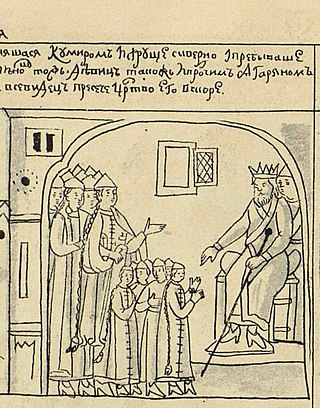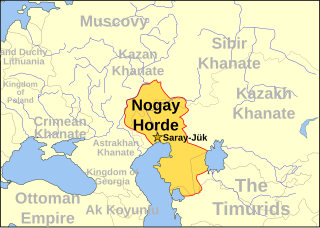
The Ural Mountains, or simply the Urals, are a mountain range in Eurasia that runs north–south mostly through the Russian Federation, from the coast of the Arctic Ocean to the river Ural and northwestern Kazakhstan. The mountain range forms part of the conventional boundary between the continents of Europe and Asia, marking the separation between European Russia and Siberia. Vaygach Island and the islands of Novaya Zemlya form a further continuation of the chain to the north into the Arctic Ocean. The average altitudes of the Urals are around 1,000–1,300 metres (3,300–4,300 ft), the highest point being Mount Narodnaya, which reaches a height of 1,894 metres (6,214 ft).

The Bashkirs or Bashkorts are a Turkic ethnic group indigenous to Russia. They are concentrated in Bashkortostan, a republic of the Russian Federation and in the broader historical region of Badzhgard, which spans both sides of the Ural Mountains, where Eastern Europe meets North Asia. Smaller communities of Bashkirs also live in the Republic of Tatarstan, the oblasts of Perm Krai, Chelyabinsk, Orenburg, Tyumen, Sverdlovsk and Kurgan and other regions in Russia; sizeable minorities exist in Kazakhstan and Uzbekistan.

The Khanate of Sibir was a state in western Siberia. It was founded at the end of the 15th century, following the break-up of the Golden Horde. Throughout its history, members of the Shaybanid and Taibugid dynasties often contested the rulership over the Khanate between each other; both of these competing tribes were direct patrilineal descendants of Genghis Khan through his eldest son Jochi and Jochi's fifth son Shayban (Shiban). The area of the Khanate had once formed an integral part of the Mongol Empire, and later came under the control of the White Horde and the Golden Horde of 1242–1502.

Bashkortostan or Bashkiria, officially the Republic of Bashkortostan, is a republic of Russia between the Volga river and the Ural Mountains in Eastern Europe. The republic borders Perm Krai to the north, Sverdlovsk Oblast to the northeast, Chelyabinsk Oblast to the east, Orenburg Oblast to the south, Tatarstan to the west and Udmurtia to the northwest. It covers 143,600 square kilometres and has a population of 4 million. It is the seventh-most populous federal subject in Russia and the most populous republic. Its capital and largest city is Ufa.

Yermak Timofeyevich was a Cossack ataman and is today a hero in Russian folklore and myths. During the reign of the Russian tsar Ivan the Terrible, Yermak started the Russian conquest of Siberia.

Kuchum Khan was the last Khan of Siberia who ruled from 1563 to 1598.
Salawat Yulayev was a Bashkir national hero who helped lead the Pugachev's Rebellion. He was also a poet and singer.

The Nogai Horde was a confederation founded by the Nogais that occupied the Pontic–Caspian steppe from about 1500 until they were pushed west by the Kalmyks and south by the Russians in the 17th century. The Mongol tribe called the Manghuds constituted a core of the Nogai Horde.

Ural is a geographical region located around the Ural Mountains, between the East European and West Siberian plains. It is considered a part of the Eurasian Steppe, extending approximately from the North to the South; from the Arctic Ocean to the end of the Ural River near Orsk city. The border between Europe and Asia runs along the Eastern side of the Ural Mountains. Ural mostly lies within Russia but also includes a small part of Northwestern Kazakhstan. This is historical, not an official entity, with borders overlapping its Western Volga and Eastern Siberia neighboring regions. At some point in the past, parts of the currently existing Ural region were considered a gateway to Siberia, or even Siberia itself, and were combined with the Volga administrative the divisions. Today, there are two official namesake entities: the Ural Federal District and the Ural economic region. While the latter follows the historical borders, the former is a political product; the District omits Western Ural and includes Western Siberia instead.

The steppe and forest-steppe of Ukraine and southern Russia, traditionally held by pastoral nomads, provided agricultural opportunities. States that were able to settle the land with tax-paying peasants could significantly increase their power. From 1500 to 1800, this region came under Russian control.

The Khanate of Sibir was a Muslim state located just east of the middle Ural Mountains. Its conquest by Yermak Timofeyevich in 1582 was the first event in the Russian conquest of Siberia.
The history of Bashkortostan or Bashkiria covers the region in and around the Southern Urals, historically inhabited by Bashkirs. The region has been known by several names, including al-Bashgird, Bashgirdia, Bascardia, Fiyafi Bashqurt, Pascatir and similar variants. As with previous names, the modern federal subject of Bashkortostan was named after the native Bashkir people.

The Kalmyk Khanate was an Oirat Mongol khanate on the Eurasian steppe. It extended over modern Kalmykia and surrounding areas in the North Caucasus, including Stavropol and Astrakhan. During their independence, the Kalmyks both raided and allied with Russia in turn, engaging in numerous military expeditions against the Crimean Tatars, the Ottoman Empire, neighboring Muslim tribes, and the highlanders of the North Caucasus. The Khanate was annexed by the Russian Empire in 1771.
The Bashkir Rebellion from 1704 to 1711 was one of the longest in the series of Bashkir rebellions in the 17th and 18th centuries in the Russian Empire. The Bashkir uprisings of 1662–1664, 1681–1684, and 1704-1711 have been treated at length by Soviet and post-Soviet historians as evidence of Bashkiria's gradual incorporation into the empire and of Bashkir resistance to colonial oppression.
The Bashkir rebellion of 1735–1740 refers to a rebellion by the Bashkirs against the Russian Empire. It started in 1735, but was put down by Russian troops in 1740 after a series of heavy clashes.
The Bashkir rebellion of 1681–1684 was one of the major Bashkir uprisings of the second half of the 17th century.
The siege of Ufa was a battle between Bashkir rebels and the Russian army.
TheSiege of Menzelinsk was a 1682 battle between the Tsardom of Russia against the Kalmyk Khanate and Bashkir rebels.
"Sultan" Murat Kuchukov was a Bashkir Islamic preacher and military commander, known for participating in the 1704–1711 Bashkir rebellion and starting the 1708 Insurgency in Chechnya.
He was descendant of Genghis Khan and due to his knowledge on the dogmas of Islam, he earned himself the nickname "Saint of the Mohammedan law".
The Bashkir liberation movement is a series of military clashes and uprisings of the Bashkir people against the Russian Empire that colonized Bashkortostan, as well as protests and rallies against the policies of the Russian Federation.









